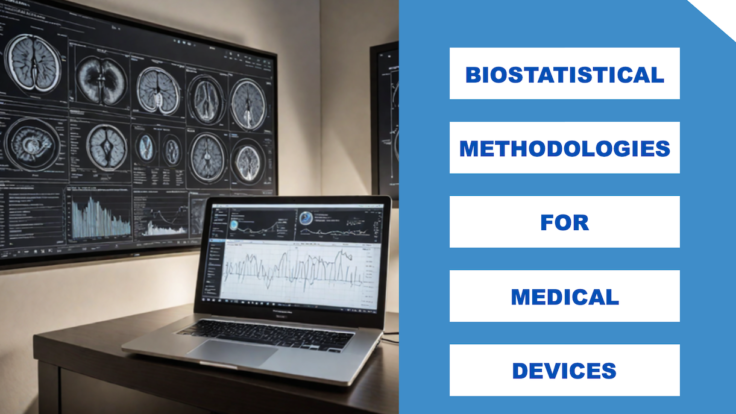
Last Updated on September 10, 2025 by BIOMEDRIC
The evolution of medical devices has underscored the critical role of biostatistics in clinical trials, where the integrity of scientific research meets the rigors of regulatory scrutiny. While delving into the intricate landscape of biostatistical methods, it is essential to appreciate not only the mathematical models that underpin these techniques but also the broader implications they have on patient safety, treatment efficacy, and the advancement of medical technology.
This article aims to elucidate the multifaceted biostatistical methods employed in clinical trials for medical devices, emphasizing their importance in hypothesis formulation, study design, data analysis, and interpretation of results.
Design and Implementation
At the heart of any clinical trial lies a well-defined hypothesis. In the context of medical devices, this often involves evaluating the safety and effectiveness of a new intervention compared to standard treatment or a placebo. Biostatistical methods play a pivotal role in hypothesis formulation, where researchers must delineate clear, testable statements that can guide the trial’s trajectory. The formulation of these hypotheses is often based on prior studies, preliminary data, and an understanding of the clinical context. Statistical significance, typically denoted by p-values, becomes a foundational element in assessing the validity of these hypotheses.
The design of clinical trials for medical devices is uniquely challenging due to the diverse nature of devices and their intended uses. Biostatistical approaches such as randomized controlled trials (RCTs), cohort studies, and crossover designs are commonly employed. RCTs, regarded as the gold standard, utilize randomization to mitigate biases and confounding variables, ensuring that the treatment effects can be attributed to the device under investigation. Biostatisticians must carefully consider sample size calculations to ensure adequate power to detect clinically meaningful differences between groups. This involves estimating the expected effect size, variability within the population, and the acceptable type I and type II error rates.
In addition to traditional designs, adaptive trial designs have emerged as a prominent method in the evaluation of medical devices. These designs allow for modifications to the trial protocol based on interim analyses of data, enabling researchers to make informed decisions about continuing, stopping, or altering the trial. By employing methods such as group sequential designs or Bayesian approaches, adaptive trials can enhance efficiency and ethical considerations, particularly when dealing with devices that may have immediate implications for patient care.
Analysis and Interpretation
Once the trial is underway, data collection and management become paramount. Biostatistical methods for data analysis encompass a wide array of techniques, including descriptive statistics, inferential statistics, and advanced modeling approaches. Descriptive statistics provide a summary of the sample characteristics, while inferential statistics facilitate the generalization of findings to a larger population. For medical devices, which often involve ordinal or categorical outcomes, specialized statistical techniques such as logistic regression or survival analysis become indispensable. The choice of statistical method hinges on the nature of the data, the study design, and the specific research questions posed by the investigators.
Moreover, the interpretation of results in the context of medical device trials requires a nuanced understanding of both statistical and clinical significance. Biostatisticians play a crucial role in communicating findings to stakeholders, including regulatory bodies, clinicians, and patients. The challenge lies not only in presenting data clearly but also in contextualizing the outcomes within the framework of clinical relevance. For instance, a statistically significant improvement in a device’s performance may not translate into meaningful benefits for patients unless it is accompanied by robust evidence of safety and quality of life enhancement.
In the regulatory landscape, biostatistics is integral to the submission processes for medical devices. Regulatory agencies, such as the Food and Drug Administration (FDA) in the United States and the European Medicines Agency (EMA) in Europe (EU MDR is the contemporary regulation of the European Union that focuses on the medical devices in European markets; many rules and regulations were updated to provide the topmost health care and well-being for people), rely heavily on biostatistical evidence to make informed decisions about device approvals. The meticulous documentation of statistical analyses, methodologies, and results is necessary for adherence to regulatory guidelines, ensuring that the devices meet established safety and efficacy standards.
- In conclusion, biostatistical methods are foundational to the success of clinical trials for medical devices. From hypothesis formulation to study design, data analysis, and regulatory submission, these methods serve as the bedrock of scientific research in the medical device field. As technology continues to advance and new devices emerge, the role of biostatistics will only become more pronounced, guiding researchers in their quest to improve patient outcomes and revolutionize healthcare. The intersection of biostatistics and medical device trials not only enhances the rigor of clinical research but also underscores the ethical imperative of ensuring that innovations in medical technology are rooted in solid scientific evidence.
BIOMEDRIC Support for Medical Device Manufacturers
BIOMEDRIC specializes in providing high-end support for all sorts of medical devices and in-vitro diagnostic medical devices regarding preclinical stage, clinical stage, and post-clinical stage. Whether you want to get FDA and/or EU approval for medical devices or want our consultancy services for medical devices, our specialists would love to know about your requirements for safe practices in the industry.
Not only this, but BIOMEDRIC also gives extensive briefings related to all aspects of medical devices and in-vitro diagnostic medical devices, their types, usage, and the laws. The interface also promotes a user-friendly outlook to assessing the needs and use of the company, with due diligence to the regulations of the FDA and EU.
Please contact us (info@biomedric.com or biomedric@gmail.com) for the top-tier consultancy, reporting, and filing services on scientific, technical, and regulatory matters you may need including Biostatistical Methods for clinical trials of medical devices.